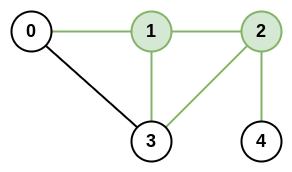There is an infrastructure of n cities with some number of
roads connecting these cities. Each roads[i] = [ai, bi]
indicates that there is a bidirectional road between cities ai
and bi.
The network rank of two different cities is defined as the total number of directly connected roads to either city. If a road is directly connected to both cities, it is only counted once.
The maximal network rank of the infrastructure is the maximum network rank of all pairs of different cities.
Given the integer n and the array roads, return the
maximal network rank of the entire infrastructure.
Example 1:

Input: n = 4, roads = [[0,1],[0,3],[1,2],[1,3]] Output: 4 Explanation: The network rank of cities 0 and 1 is 4 as there are 4 roads that are connected to either 0 or 1. The road between 0 and 1 is only counted once.
Example 2:

Input: n = 5, roads = [[0,1],[0,3],[1,2],[1,3],[2,3],[2,4]] Output: 5 Explanation: There are 5 roads that are connected to cities 1 or 2.
Example 3:
Input: n = 8, roads = [[0,1],[1,2],[2,3],[2,4],[5,6],[5,7]] Output: 5 Explanation: The network rank of 2 and 5 is 5. Notice that all the cities do not have to be connected.
Constraints:
2 <= n <= 1000 <= roads.length <= n * (n - 1) / 2roads[i].length == 20 <= ai, bi <= n-1ai != bi- Each pair of cities has at most one road connecting them.
Difficulty:
MediumLock:
NormalCompany:
MicrosoftProblem Solution
1615-Maximal-Network-RankAll Problems:
Link to All Problems
All contents and pictures on this website come from the Internet and are updated regularly every week. They are for personal study and research only, and should not be used for commercial purposes. Thank you for your cooperation.